For New Insights into Aerodynamics, Scientists Turn to Paper Airplanes
A series of experiments using paper airplanes reveals new aerodynamic effects--findings that enhance our understanding of flight stability.
Findings Unveil Mechanisms that Explain Flight Stability
A series of experiments using paper airplanes reveals new aerodynamic effects, a team of scientists has discovered. Its findings enhance our understanding of flight stability and could inspire new types of flying robots and small drones.
“The study started with simple curiosity about what makes a good paper airplane and specifically what is needed for smooth gliding,” explains Leif Ristroph, an associate professor at New York University’s Courant Institute of Mathematical Sciences and an author of the study , which appears in the Journal of Fluid Mechanics . “Answering such basic questions ended up being far from child’s play. We discovered that the aerodynamics of how paper airplanes keep level flight is really very different from the stability of conventional airplanes.”
“Birds glide and soar in an effortless way, and paper airplanes, when tuned properly, can also glide for long distances,” adds author Jane Wang, a professor of engineering and physics at Cornell University. “Surprisingly, there has been no good mathematical model for predicting this seemingly simple but subtle gliding flight.”
Since we can make complicated modern airplanes fly, the researchers say, one might think we know all there is to know about the simplest flying machines.
“But paper airplanes, while simple to make, involve surprisingly complex aerodynamics,” notes Ristroph.
The paper’s authors began their study by considering what is needed for a plane to glide smoothly. Since paper airplanes have no engine and rely on gravity and proper design for their movement, they are good candidates for exploring factors behind flight stability.
To investigate this phenomenon, the researchers conducted lab experiments by launching paper airplanes with differing centers of mass through the air. The results, along with those from studying plates falling in a water tank, allowed the team to devise a new aerodynamic model and also a “flight simulator” capable of predicting the motions.
A video and image showing the experimental results may be downloaded from Google Drive .
To find the best design, the researchers placed different amounts of thin copper tape on the front part of the paper planes, giving them varied center of mass locations. Lead weights added to the plates in water served the same purpose.
“The key criterion of a successful glider is that the center of mass must be in the ‘just right’ place,” Ristroph explains. “Good paper airplanes achieve this with the front edge folded over several times or by an added paper clip, which requires a little trial and error.”
In the experiments, the researchers found that the flight motions depended sensitively on the center of mass location. Specifically, if the weight was at the center of the wing or only displaced somewhat from the middle, it underwent wild motions, such as fluttering or tumbling. If the weight was displaced too far toward one edge, then the flier quickly dove downwards and crashed. In between, however, there was a “sweet spot” for the center of mass that gave stable gliding.
The researchers coupled the experimental work with a mathematical model that served as the basis of a “flight simulator,” a computer program that successfully reproduced the different flight motions. It also helped explain why a paper airplane is stable in its glide. When the center of mass is in the “sweet spot,” the aerodynamic force on the plane’s wing pushes the wing back down if the plane moves upward and back up if it moves downward.
“The location of the aerodynamic force or center of pressure varies with the angle of flight in such a way to ensure stability,” explains Ristroph.
He notes that this dynamic does not occur with conventional aircraft wings, which are airfoils—structures whose shapes work to generate lift.
“The effect we found in paper airplanes does not happen for the traditional airfoils used as aircraft wings, whose center of pressure stays fixed in place across the angles that occur in flight,” Ristroph says. “The shifting of the center of pressure thus seems to be a unique property of thin, flat wings, and this ends up being the secret to the stable flight of paper airplanes.”
“This is why airplanes need a separate tail wing as a stabilizer while a paper plane can get away with just a main wing that gives both lift and stability,” he concludes. “We hope that our findings will be useful in small-scale flight applications, where you may want a minimal design that does not require a lot of extra flight surfaces, sensors, and controllers.”
The paper’s other authors were Huilin Li, a doctoral candidate at NYU Shanghai, and Tristan Goodwill, a doctoral candidate at the Courant Institute’s Department of Mathematics.
The work was supported by grants from the National Science Foundation (DMS-1847955, DMS-1646339).

Press Contact
- Mobile Site
- Staff Directory
- Advertise with Ars
Filter by topic
- Biz & IT
- Gaming & Culture
Front page layout
On the eleventh day of Christmas —
Experiments with paper airplanes reveal surprisingly complex aerodynamics, how these gliders keep level flight is different from the stability of airplanes..
Jennifer Ouellette - Jan 4, 2023 10:06 pm UTC
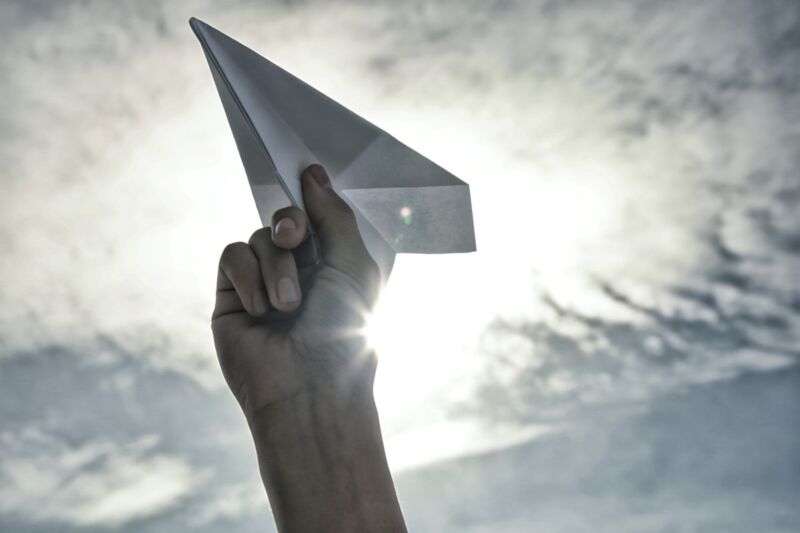
Drop a flat piece of paper and it will flutter and tumble through the air as it falls, but a well-fashioned paper airplane will glide smoothly. Although these structures look simple, their aerodynamics are surprisingly complex. Researchers at New York University’s Courant Institute of Mathematical Sciences conducted a series of experiments involving paper airplanes to explore this transition and develop a mathematical model to predict flight stability, according to a March paper published in the Journal of Fluid Mechanics.
“The study started with simple curiosity about what makes a good paper airplane and specifically what is needed for smooth gliding," said co-author Leif Ristroph . "Answering such basic questions ended up being far from child’s play. We discovered that the aerodynamics of how paper airplanes keep level flight is really very different from the stability of conventional airplanes.”
Nobody knows who invented the first paper airplane, but China began making paper on a large scale around 500 BCE, with the emergence of origami and paper-folding as a popular art form between 460 and 390 BCE. Paper airplanes have long been studied as a means of learning more about the aerodynamics of flight. For instance, Leonardo da Vinci famously built a model plane out of parchment while dreaming up flying machines and used paper models to test his design for an ornithopter. In the 19th century, British engineer and inventor Sir George Cayley —sometimes called the "father of aviation"—studied the gliding performance of paper airplanes to design a glider capable of carrying a human.
An amusing "scientist playing with paper planes" anecdote comes from physicist Theodore von Kármán . In his 1967 memoir The Wind and Beyond , he recalled a formal 1924 banquet in Delft, The Netherlands, where fellow physicist Ludwig Prandtl constructed a paper airplane out of a menu to demonstrate the mechanics of flight to von Kármán's sister, who was seated next to him. When he threw the paper plane, "It landed on the shirtfront of the French minister of education, much to the embarrassment of my sister and others at the banquet," von Kármán wrote.
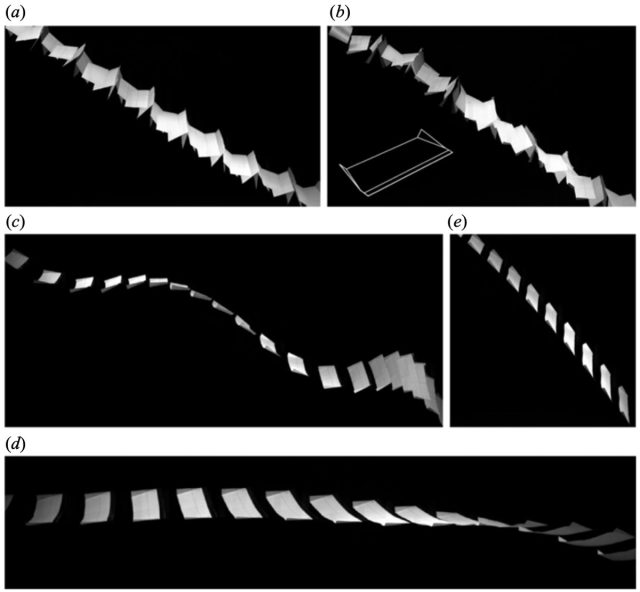
While scientists have clearly made great strides in aerodynamics—particularly about aircraft—Ristroph et al . noted that there was not a good mathematical model for predicting the simpler, subtler gliding flight of paper airplanes. It was already well-known that displacing the center of mass results in various flight trajectories, some more stable than others. “The key criterion of a successful glider is that the center of mass must be in the ‘just right’ place,” said Ristroph . “Good paper airplanes achieve this with the front edge folded over several times or by an added paper clip, which requires a little trial and error.”
reader comments
Channel ars technica.
Academia.edu no longer supports Internet Explorer.
To browse Academia.edu and the wider internet faster and more securely, please take a few seconds to upgrade your browser .
Enter the email address you signed up with and we'll email you a reset link.
- We're Hiring!
- Help Center

On the Aerodynamics of Paper Airplanes

2009, AIAA Proceedings.[np]. 22-25 …
Related Papers
Journal of Advanced Research in Fluid Mechanics and Thermal Sciences
Iskandar Shah Ishak
Paper plane has a high potential to be upgraded as a Micro Air Vehicle (MAV). Due to its simplicity, paper plane offers easier design option compared to the biological inspired designs as shown in recent MAV development. However, researchers have underestimate and overlook the basic aerodynamic performance induced by these paper planes. This is due to its common usage as toys and wide range of paper plane design. Thus, the objective for current work is to analyse and compare the aerodynamics forces and its performance for selected paper plane design known as Glider, Wide Stunt Glider Plane and Stunt plane. A series of CFD simulations on each paper plane was executed by using ANSYS-CFX module. A steady state, incompressible flow Navier-Stokes equation (RANS) combined with Shear Stress Turbulence (SST) model were used in this works to solve flow problem over the paper planes. The analysis is mainly conducted to study and compare the lift coefficient (), drag coefficient ()and aerodyna...
Science China-technological Sciences
Tianhang Xiao
This paper summaries the investigations on natural flyers and development of bio-mimetic micro air vehicles (MAVs) at NUAA, China, where the authors have led a group to conduct research for a decade. The investigations include the studies of low Reynolds number aerodynamics, unsteady computational fluid dynamics and flight control for the fixed-wing MAVs, the bird-like MAVs, the dragonfly-like MAVs and the bee-like MAVs.
Experiments in Fluids
max platzer
In this paper, the decade of numerical and experimental investigations leading to the development of the authors' unique flapping-wing micro air vehicle is summarized. Early investigations included the study of boundary layer energization by means of a small flapping foil embedded in a flat-plate boundary layer, the reduction of the recirculatory flow region behind a backward-facing step by means of
Salman Ansari
Insect-like flapping flight offers a power-efficient and highly manoeuvrable basis for micro air vehicles for indoor applications. Some aspects of the aerodynamics associated with the sweeping phase of insect wing kinematics are examined by making particle image velocimetry measurements on a rotating wing immersed in a tank of seeded water. The work is motivated by the paucity of data with quantified error on insect-like flapping flight, and aims to fill this gap by providing a detailed description of the experimental setup, quantifying the uncertainties in the measurements and explaining the results. The experiments are carried out at two Reynolds numbers—500 and 15,000—accounting for scales pertaining to many insects and future flapping-wing micro air vehicles, respectively. The results from the experiments are used to describe prominent flow features, and Reynolds number-related differences are highlighted. In particular, the behaviour of the leading-edge vortex at these Reynolds numbers is studied and the presence of Kelvin–Helmholtz instability observed at the higher Reynolds number in computational fluid dynamics calculations is also verified.
44th AIAA Aerospace Sciences Meeting and Exhibit
Shwetanshu Gaurav
A comprehensive numerical simulation of fluid dynamics based study of a pleated wing section based on the wing of Aeshna Cyanea has been performed at ultra-low Reynolds number corresponding to the gliding flight of these dragonflies in order to explore the potential applications of pleated airfoils for micro air vehicle applications. The simulation employs an unstructured triangular mesh based on finite volume discretization done in the ANSYS-14.0 using WorkBench14.0.Whenever, dragonfly wing interacts with the fluid (air taken), several forces and vibrations results out. These forces and vibrations cause certain changes over the dimensional structure over the wing and also influence the flows characteristics. A critical assessment of the computed results was performed. In this work, various flow patterns and aerodynamic performance of pleated airfoil has been obtained at ultra-low Reynolds numbers (2000-3000) at different angle of attacks (AOA) ranging from 0 ° to15 °. Also there effects on coefficient of Lift and Drag have been analysed. The simulations demonstrate that pleated airfoil produces higher lift and moderate drag that lead to an aerodynamic performance and hence pleated airfoil is an excellent choice for a fixed wing micro-air vehicle application.
Interface Focus
Robert Siddall
Aerial robots capable of locomotion in both air and water would enable novel mission profiles in complex environments, such as water sampling after floods or underwater structural inspections. The design of such a vehicle is challenging because it implies significant propulsive and structural design trade-offs for operation in both fluids. In this paper, we present a unique Aquatic Micro Air Vehicle (AquaMAV), which uses a reconfigurable wing to dive into the water from flight, inspired by the plunge diving strategy of water diving birds in the family Sulidae . The vehicle's performance is investigated in wind and water tunnel experiments, from which we develop a planar trajectory model. This model is used to predict the dive behaviour of the AquaMAV, and investigate the efficacy of passive dives initiated by wing folding as a means of water entry. The paper also includes first field tests of the AquaMAV prototype where the folding wings are used to initiate a plunge dive.
29th AIAA Applied Aerodynamics Conference
ROSHAN JOSEPH ANTONY
INCAS BULLETIN,
Yagya D U T T A Dwivedi
Corrugations are folds on a surface as found on wings of dragon fly insects. Although they fly at relatively lower altitudes its wings are adapted for better aerodynamic and aero-elastic characteristics. In the present work, three airfoil geometries were studied using the 2-D panel method to evaluate the aerodynamic performance for low Reynolds number. The experiments were conducted in wind tunnel for incompressible flow regime to demonstrate the coefficients of lift drag and glide ratio at two Reynolds numbers 1.9x10 4 and 1.5x10 5 and for angles of attack ranging between 0 0 and 16 0. The panel method results have been validated using the current and existing experiment data as well as with the computational work from cited literature. A good agreement between the experimental and the panel methods were found for low angles of attack. The results showed that till 8 0 angle of attack higher lift coefficient and lower drag coefficient are obtainable for corrugated airfoils as compared to NACA 0010. The validation of surface pressure coefficients for all three airfoils using the panel method at 4 0 angles of attack was done. The contours of the non-dimensional pressure and velocity are illustrated from-10 0 to 20 0 angles of attack. A good correlation between the experiment data and the computational methods revealed that the corrugated airfoils exhibit better aerodynamic performance than NACA 0010.
RELATED PAPERS
International Journal of Modern Physics A
Sameer Ikhdair
Quintana: revista de estudios do Departamento de Historia da Arte
Madeline Caviness
Journal of Biological Chemistry
Open Access Journal of Nursing
GMS Zeitschrift für medizinische Ausbildung
Sören Huwendiek
Global Sociological Review
Ahmed Usman
Journal of Water, Sanitation and Hygiene for Development
Jane Moraa Adogo
HAL (Le Centre pour la Communication Scientifique Directe)
Kremena Makasheva
Journal of Maxillofacial and Oral Surgery
Ramen Sinha
Jurnal Gema Ngabdi
Mustarum Musaruddin
Investigación en Educación Médica
Jose Sanguinetti
ERASMUSYOUTH2022CB
Dorothea Papathanasiou
Travis White
International Journal of Research in Medical Sciences
International Journal of Marine Energy
Vladimir Miskov
滑铁卢大学毕业证文凭 购买加拿大Waterloo文凭学历
Journal of Investigative and Clinical Dentistry
May Mahasantipiya
The Electricity Journal
martin maticka
在线购买brock毕业证书 加拿大布鲁克大学毕业证毕业文凭证书注册证明原版一模一样
GIGA Focus Lateinamerika
Detlef Nolte
- We're Hiring!
- Help Center
- Find new research papers in:
- Health Sciences
- Earth Sciences
- Cognitive Science
- Mathematics
- Computer Science
- Academia ©2024
An official website of the United States government
Here's how you know
Official websites use .gov A .gov website belongs to an official government organization in the United States.
Secure .gov websites use HTTPS. A lock ( Lock Locked padlock ) or https:// means you've safely connected to the .gov website. Share sensitive information only on official, secure websites.
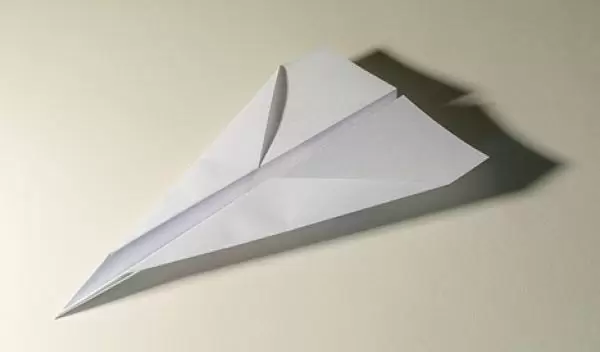
Scientists experiment with paper planes to study aerodynamics, flight stability
The properties that make a paper airplane fly have much to tell scientists about aerodynamics and flight stability, according to U.S. National Science Foundation grantee researchers at New York University . They conducted a series of experiments using paper planes to make their conclusions.
The research could influence the development of airborne vehicles like drones. The team's research was published in the Journal of Fluid Mechanics .
"The study started with simple curiosity about what makes a good paper airplane and specifically what is needed for smooth gliding," said Leif Ristroph, an author of the study. "Answering such basic questions ended up being far from child's play. We discovered that the aerodynamics of how paper airplanes keep level flight is very different from the stability of conventional airplanes."
Paper planes rely on gravity and proper design to successfully glide.
"Birds glide and soar in an effortless way, and paper airplanes, when tuned properly, can also glide for long distances," added co-author Jane Wang. "Surprisingly, there has been no good mathematical model for predicting this seemingly simple but subtle gliding flight."
Paper planes appear unassuming in design and composition, "But paper airplanes, while simple to make, involve surprisingly complex aerodynamics," said Ristroph.
The researchers launched paper planes with different centers of mass, observed paper planes descending into a water tank, and used the data to develop a new aerodynamic model and flight simulator that successfully replicates flight motions.
"The key criterion of a successful glider is that the center of mass must be in the 'just right' place," Ristroph said. "Good paper airplanes achieve this with the front edge folded over several times or by an added paper clip, which requires a little trial and error. The location of the aerodynamic force or center of pressure varies with the angle of flight to ensure stability."
The effect the team found in paper airplanes doesn't happen in the traditional airfoils used as aircraft wings, whose center of pressure stays fixed in place across the angles that occur in flight, according to Ristroph. "The shifting of the center of pressure seems to be a unique property of thin, flat wings, and this ends up being the secret to the stable flight of paper airplanes."
Research areas
Futurity is your source of research news from leading universities.
- About Futurity
- Universities
- Environment
Paper airplanes show off new aerodynamic effects
Since we can make complicated modern airplanes fly, one might think we know all there is to know about the simplest flying machines. "But paper airplanes, while simple to make, involve surprisingly complex aerodynamics," says Leif Ristroph. (Credit: Jeremy Bezanger/Unsplash )
You are free to share this article under the Attribution 4.0 International license.
- aerodynamics
A series of experiments using paper airplanes has revealed new aerodynamic effects, researchers report.
The findings enhance our understanding of flight stability and could inspire new types of flying robots and small drones.
“The study started with simple curiosity about what makes a good paper airplane and specifically what is needed for smooth gliding,” says Leif Ristroph, an associate professor at New York University’s Courant Institute of Mathematical Sciences and an author of the study in the Journal of Fluid Mechanics .
“…paper airplanes, while simple to make, involve surprisingly complex aerodynamics.”
“Answering such basic questions ended up being far from child’s play. We discovered that the aerodynamics of how paper airplanes keep level flight is really very different from the stability of conventional airplanes.”
“Birds glide and soar in an effortless way, and paper airplanes, when tuned properly, can also glide for long distances,” says author Jane Wang, a professor of engineering and physics at Cornell University. “Surprisingly, there has been no good mathematical model for predicting this seemingly simple but subtle gliding flight.”
Since we can make complicated modern airplanes fly, the researchers say, one might think we know all there is to know about the simplest flying machines.
“But paper airplanes, while simple to make, involve surprisingly complex aerodynamics,” Ristroph says.
‘Just right’ center of mass
To begin their study, researchers considered what is needed for a plane to glide smoothly. Since paper airplanes have no engine and rely on gravity and proper design for their movement, they are good candidates for exploring factors behind flight stability.
To investigate this phenomenon, the researchers conducted lab experiments by launching paper airplanes with differing centers of mass through the air. The results, along with those from studying plates falling in a water tank, allowed the team to devise a new aerodynamic model and also a “flight simulator” capable of predicting the motions.
To find the best design, the researchers placed different amounts of thin copper tape on the front part of the paper planes, giving them varied center of mass locations. Lead weights added to the plates in water served the same purpose.
“The key criterion of a successful glider is that the center of mass must be in the ‘just right’ place,” Ristroph explains. “Good paper airplanes achieve this with the front edge folded over several times or by an added paper clip, which requires a little trial and error.”
In the experiments, the researchers found that the flight motions depended sensitively on the center of mass location.
Specifically, if the weight was at the center of the wing or only displaced somewhat from the middle, it underwent wild motions, such as fluttering or tumbling. If the weight was displaced too far toward one edge, then the flier quickly dove downwards and crashed. In between, however, there was a “sweet spot” for the center of mass that gave stable gliding.
Aerodynamic ‘sweet spot’
The researchers coupled the experimental work with a mathematical model that served as the basis of a “flight simulator,” a computer program that successfully reproduced the different flight motions. It also helped explain why a paper airplane is stable in its glide.
When the center of mass is in the “sweet spot,” the aerodynamic force on the plane’s wing pushes the wing back down if the plane moves upward and back up if it moves downward.
“The location of the aerodynamic force or center of pressure varies with the angle of flight in such a way to ensure stability,” Ristroph explains.
He notes that this dynamic does not occur with conventional aircraft wings , which are airfoils—structures whose shapes work to generate lift.
“The effect we found in paper airplanes does not happen for the traditional airfoils used as aircraft wings, whose center of pressure stays fixed in place across the angles that occur in flight,” Ristroph says. “The shifting of the center of pressure thus seems to be a unique property of thin, flat wings, and this ends up being the secret to the stable flight of paper airplanes.”
“This is why airplanes need a separate tail wing as a stabilizer while a paper plane can get away with just a main wing that gives both lift and stability,” he says. “We hope that our findings will be useful in small-scale flight applications, where you may want a minimal design that does not require a lot of extra flight surfaces, sensors, and controllers.”
The National Science Foundation supported the work.
Source: NYU
Bird-like morphing wings could stabilize drones in flight
Little bat-winged dinos could glide, but not fly, stay connected. subscribe to our newsletter..
Add your information below to receive daily updates.
- Comments This field is for validation purposes and should be left unchanged.
You are using an outdated browser. Please upgrade your browser to improve your experience.
Science on Screen
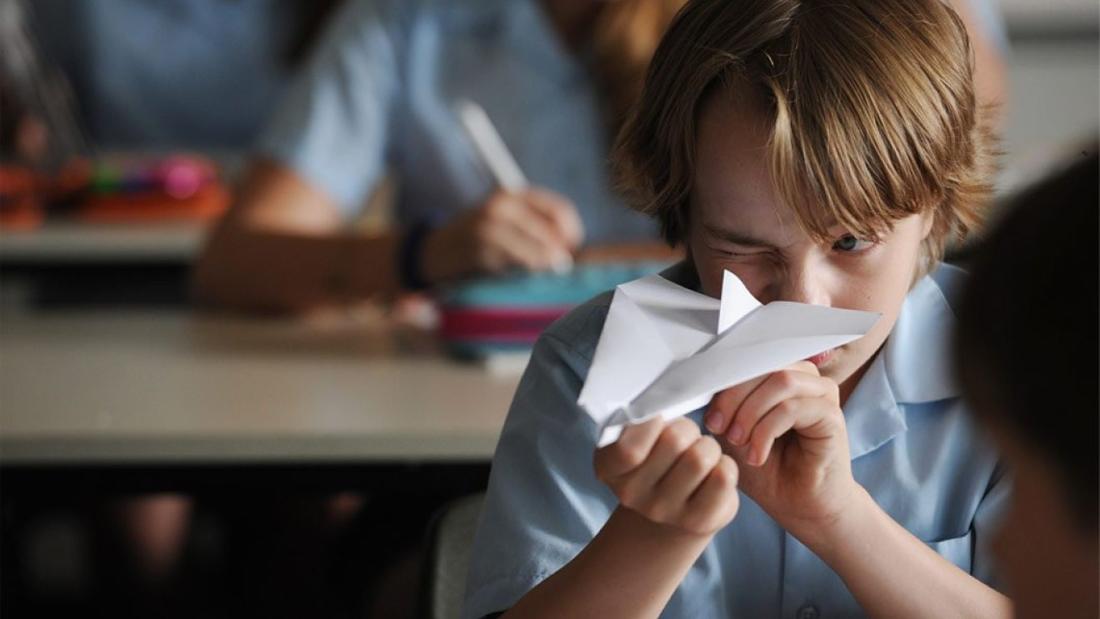
Cameo Cinema St Helena, CA
John Collins
Guinness Book of World Records record holder for farthest flight by a paper airplane
Paper Planes— The aerodynamics of paper airplanes
Program description.
John "The Paper Airplane Guy" Collins, whose record-setting paper airplane design is featured in the film, leads this live-streamed paper airplane workshop for families. Learn why different folds move planes in different ways and how to fold five amazing paper planes: the Boomerang, the Boomerang 2, the Bat Plane, the Tumbling Wing, and "Suzanne," the plane that earned John the world record for farthest flight by a paper airplane.
Co-hosted by WIRED magazine.

Presented At
Film synopsis.
After he wins his school's paper plane making contest, 11-year-old Dylan and his grief-stricken father reconnect as Dylan prepares for the World Paper Plane Championships in Tokyo.
Paper Planes tells the story of a young Australian boy's passion for flight and his journey to compete in the world paper plane championships in Japan. On the way, twelve-year-old Dylan discovers his own talents, rekindles his bond with his depressed father, battles a bully who wants to win at any cost, and meets junior Japanese champion Kimi in the national paper plane championships in Sydney, Australia. When Sam and Kimi develop a close bond, they challenge each other to create a paper plane that has never been seen before.
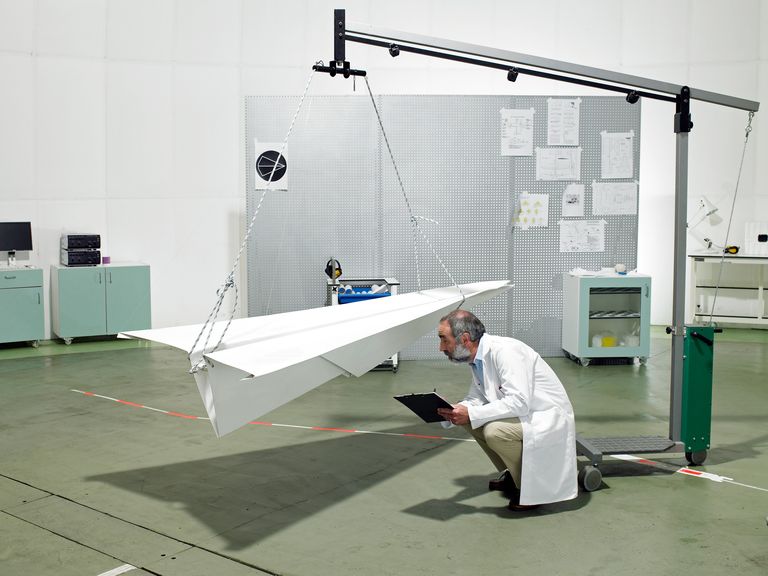
A Living History of The Humble Paper Airplane
For centuries, paper airplanes have unlocked the science of flight—now they could inspire drone technology.
Shinji Suzuki met Takuo Toda in 1999, atop Mt. Yonami in the southern city of Jinseki-Kogen, Japan. Toda, the chairman of the Japan Origami Airplane Association, was there to launch a large paper plane from a tower he had built on the mountaintop for just that purpose.
Toda’s lofty dream inspired Suzuki to take action, and in 2008, the pair announced a project to launch paper airplanes from the International Space Station (ISS). Critics suggested these planes would burn up on their descent back to Earth, Suzuki says. However, he predicted that with a protective coating and a controlled trajectory, they might actually be able to avoid burning up on reentry into Earth’s atmosphere. Another challenge? Figuring out where exactly the planes would land.

While Suzuki plotted the planes’ journey to the ISS, Toda would chart another path, racking up Guinness World Records for his paper airplane designs . For decades, he’s aimed to break the 30-second record for time aloft of a paper plane. He’s come close multiple times.
At a Japan Airlines hangar near Tokyo’s Haneda Airport in 2009, Toda sent a paper plane soaring for a whopping 26.1 seconds. And he holds the current time aloft record, which he set in 2010 with a rectangular design that lingered in the air for an astonishing 29.2 seconds. There are other records to be broken, too. As of April 2023, a trio of aerospace engineers currently hold the title for longest-distance throw of a paper airplane. Their dart-shaped plane traveled 289 feet and 9 inches, beating the previous record by almost 40 feet.

Our obsession with testing the boundaries of folded flight is relatively recent, but our desire to explore and explain the complex world of aerodynamics goes back much further.
Chinese engineers are thought to have invented what could be considered the earliest paper planes around 2,000 years ago. But these ancient gliders, usually crafted from bamboo and paper or linen, resembled kites more than the dart-shaped fliers that have earned numerous Guinness World Records in recent years.
Leonardo da Vinci would take a step closer to the modern paper airplane in the late 14th and early 15th centuries by building paper models of his aircraft designs to assess how they might sustain flight. But da Vinci’s knowledge of aerodynamics was fairly limited. He was more inspired by animal flight and, as a result, his design for craft like the ornithopter—a hang-glider-size set of bat wings that used mechanical systems powered by human movement—never left the ground.
Paper airplanes helped early engineers and scientists learn about the mechanics of flight. The British engineer and aviator Sir George Cayley reportedly crafted the first folded paper plane to approach modern specifications in the early 1800s as part of his personal experimentation with aerodynamics. “He was one of the early people to link together the idea that the lift from the wings picking up the aircraft for stable flight must be greater than or equal to the weight of the aircraft,” says Jonathan Ridley , PhD, the head of engineering and a scholar of early aviation at Solent University in the U.K.
.css-2l0eat{font-family:UnitedSans,UnitedSans-roboto,UnitedSans-local,Helvetica,Arial,Sans-serif;font-size:1.625rem;line-height:1.2;margin:0rem;padding:0.9rem 1rem 1rem;}@media(max-width: 48rem){.css-2l0eat{font-size:1.75rem;line-height:1;}}@media(min-width: 48rem){.css-2l0eat{font-size:1.875rem;line-height:1;}}@media(min-width: 64rem){.css-2l0eat{font-size:2.25rem;line-height:1;}}.css-2l0eat b,.css-2l0eat strong{font-family:inherit;font-weight:bold;}.css-2l0eat em,.css-2l0eat i{font-style:italic;font-family:inherit;} “Over the last 20 years, there’s been an increasing interest in smaller-scale flight.”
More than a century later, before their famous 1903 flight in Kitty Hawk, North Carolina, the Wright Brothers built paper models of wings to better understand how their glider would sustain flight, explains Ridley. They then tested these models in a rudimentary, refrigerator-size wind tunnel—only the second to be built in the U.S.
Paper planes are still illuminating the hidden wonders of flight. Today, these lightweight aircraft serve as a source of inspiration not only for aviation enthusiasts but also for fluid dynamicists and engineers studying the complex effects of air on small aircraft like drones.
At Cornell University, in a lab run by physics professor Jane Wang , PhD, paper gliders plunge, swoop, and flutter through the air. What might look like child’s play to the untrained eye is actually part of a serious experiment conducted by Wang and her colleague Leif Ristroph , PhD, an associate professor of mathematics at New York University. Once the planes land, Wang and Ristroph analyze data from their flight and apply weights to change the balance of these gliders. They hope doing so will help them better understand how lightweight objects soar—something that could one day inform the future of miniature drones and other robotic craft.

The team’s most recent study, published in the Journal of Fluid Mechanics in February 2022 , explored the mechanics of gliding and identified new ways for paper gliders to achieve stable flight. Insights gleaned from this research have practical applications, but they also shed light on the aerodynamic principles that keep paper airplanes thrown by enthusiasts up in the air. All planes —powered and unpowered —are controlled by the four forces of flight: lift, weight, thrust, and drag. Lift is the aerodynamic force produced by the forward motion of an object through a fluid—in this case, air. Weight, or the force of gravity, is the opposing force and pulls the airplane toward Earth. Where the engines or propellers on a passenger aircraft generate thrust, the force of a paper plane pilot’s throw gives the aircraft the forward momentum. Drag, caused by the friction a plane experiences as it moves through the air, acts in opposition to thrust.
Traditional airplanes have airfoil-shaped wings with a round leading edge. Air that passes over the wing conforms to its shape. Air flowing above the wing moves faster than air below the wing, forming a low-pressure zone above the wing that generates lift.
“The magic of a paper airplane is that all of these little flight corrections are happening continuously throughout its flight.”
But the wing of a paper glider is flat, and air does not flow smoothly around it. Instead, that air forms a small, low-pressure vortex immediately above the leading edge of the wing. “This little vortex ends up changing a lot of the aerodynamic characteristics of the plane,” Ristroph says. “One thing it does is give the plane a natural stability, meaning that, in principle, it can and will glide.”
As the angle at which a glider’s wing cuts through the air—known as the angle of attack—changes, so too does the size and location of the vortex above the wing. This affects where the center of pressure, or the precise location where lift is focused, lies along the wing and how responsive it is to disturbances. If, for example, the plane encounters a gust that pushes its nose down, the center of pressure will slide forward, pushing the nose back up and into a stable position.
“The magic of a paper airplane is that all of these little flight corrections are happening continuously throughout its flight,” Ristroph says. “The plane is hanging under a vortex that is constantly swelling and shrinking in just the right ways to keep a smooth and level glide.”
The center of pressure for an airfoil, however, is locked in place and does not change with the angle of attack. This means it has trouble self-correcting if destabilized. Ristroph says the team tested this in some of their experiments by folding the sheets into an airfoil. These sheets quickly crashed after brief, erratic flights because they could not stabilize after being perturbed.
This phenomenon changes at different scales, Ristroph adds. For instance, if you were to construct a paper plane the size of a Boeing 747 , the vortex above the wing would be much larger and behave differently. “That vortex would not just stay on the plane and sit there, it would jump off, reform again, and do something a little turbulent and a little crazy,” he says. “You might not be able to rely on that vortex to give you stability because it may not always be there.” Conversely, if you created a paper airplane less than, say, a millimeter long, the aerodynamics would change—along with the behavior of that vortex.
The central focus of Ristroph and Wang’s work—and, as their research suggests, the true secret to a stable glide—is identifying and making adjustments based on a glider’s center of balance. The center of balance lies at the point where a plane would be perfectly balanced if suspended in midair. (You can locate the center of balance on a paper airplane by balancing it between the tips of your thumb and forefinger.) For an unfolded sheet of paper like the ones Wang and Ristroph tested, the center of balance is directly in the middle of the page.
The team experimented with tweaking the center of balance by placing strips of copper tape on their paper gliders and studying their flight. If the weights were placed too close to the center of the sheet, the gliders would tumble uncontrollably to the ground. If the weights were placed too far forward, they would immediately nose-dive.
“People can make very, very good paper airplanes now,” Wang says. “It’s a fine art. They build their intuition by making them.”
Through trial and error, they discovered that placing these weights halfway between the middle of the sheet and the leading edge created a stable glide, meaning that even if the glider was disturbed during its flight, it would still be able to right itself. Wang says this discovery was particularly surprising because previous work done on this topic had only ever identified “neutrally stable” modes of flight, which become unstable if perturbed and cannot self-correct.
Ristroph hopes the findings from their work will help engineers design new types of small aircraft that take advantage of passive modes of flight like, say, windsurfing craft that sail high above cities to monitor air quality. “Over the last 20 years, there’s been increasing interest in smaller-scale flight,” Ristroph says. “Small-scale flying robots [could] do things like ride on the wind rather than having some kind of engine or spinning rotors like a helicopter.”

The push to develop low-cost and low-impact alternatives to traditional aircraft has grown in recent decades. For example, in 2017 the San Francisco–based research and development firm Otherlab announced it had won a grant from the Defense Advanced Research Projects Agency (DARPA) to work on a lightweight cardboard glider that could someday deliver blood, vaccines, or other critical cargo to remote locations inaccessible via other modes of transportation.
The gliders, constructed from flat-packed pieces of cardboard, would be released from an airplane and, with the help of an onboard computer, navigate to a preprogrammed set of coordinates. Otherlab and DARPA shelved the project, but the central idea—tapping into the realm of unpowered flight to solve difficult problems—lives on.
Future small aircraft may also veer away from mimicking airplanes altogether, Wang says. In addition to studying paper gliders, much of her research focuses on forms of passive flight and gliding we already find in nature, such as insects and seeds that twirl off tree limbs. Using these techniques to create small craft could create even more possibilities in years to come.
Even after locating a glider’s center of mass, Wang cautions that this discovery won’t necessarily make solving future problems facing paper craft experts or engineers any easier. She and colleagues are attempting to solve these problems mathematically. Applying these mathematical revelations to a working glider? Well, that’s another challenge entirely.
Paper airplane enthusiasts, she suggests, might have better luck crafting gliders using intuition and experimentation instead. “People can make very, very good paper airplanes now,” Wang says. “It’s a fine art. They build their intuition by making them.”
Suzuki, Toda, and their collaborators spent 18 months testing multiple designs. They coated each plane in a protective glasslike substance that would raise the heat resistance but still allow for crisp, complex folds. With this design, Suzuki hoped that they might be able to test applications for other small-scale reentry vehicles.
The team then tested a prototype glider in the University of Tokyo’s hypersonic wind tunnel, subjecting the plane to speeds as high as Mach 7 and temperatures of almost 450°F—conditions similar to those a paper plane might face when reentering Earth’s atmosphere.
With these tests under their belt, the team reached out to Japan Aerospace Exploration Agency, who agreed to fund the project. One of the agency’s astronauts, Koichi Wakata, even expressed interest in launching them from the orbiting outpost himself. Ultimately, due to budget cuts, Suzuki and Toda’s paper planes never made it to space.
As researchers explore the field of aerodynamics, and new technology continues to model this type of flight, there’s still a chance we could see paper gliders pushing boundaries in years to come.
Weird Ways to Generate Lift
Here’s how strangely shaped objects—from Frisbees to honeybees—generate lift to soar through the air.
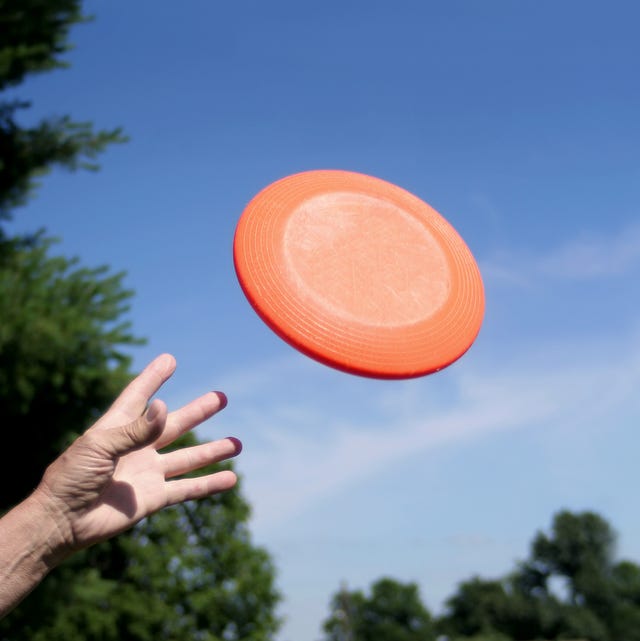
→ The lift produced by a Frisbee as it flies through the air is similar to the lift generated by an airplane’s wings. The perfect throw helps the disc push air downward without generating too much drag. In return, air pushes the Frisbee back up, generating additional lift. In 2005, researchers at MIT calculated the ideal throw angle for a Frisbee—12 degrees—to achieve maximum distance. (While the disc may travel greater heights with a larger angle, drag will shorten the distance traveled.)
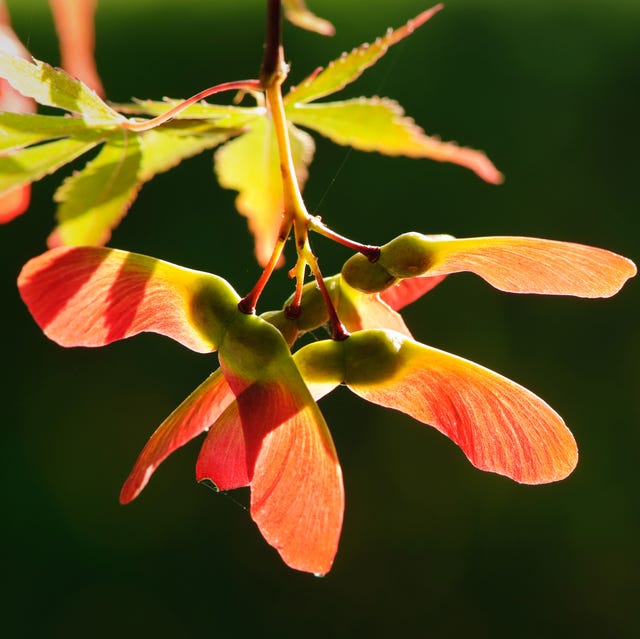
Helicopter Seeds
→ The maple tree’shelicopter-like seeds, called samara, are specifically designed to fall and spin long distances away from the large, shady canopies of their parent trees. Their long, sail-like wings help balance the weight of the asymmetrical seeds. As the seed spins, the wider end of the wing moves faster than the air closer to the seed, generating lift to keep it airborne. Veins along the wing’s edge create turbulence, forming a small vortex above the wing that reduces pressure and generates even more lift.
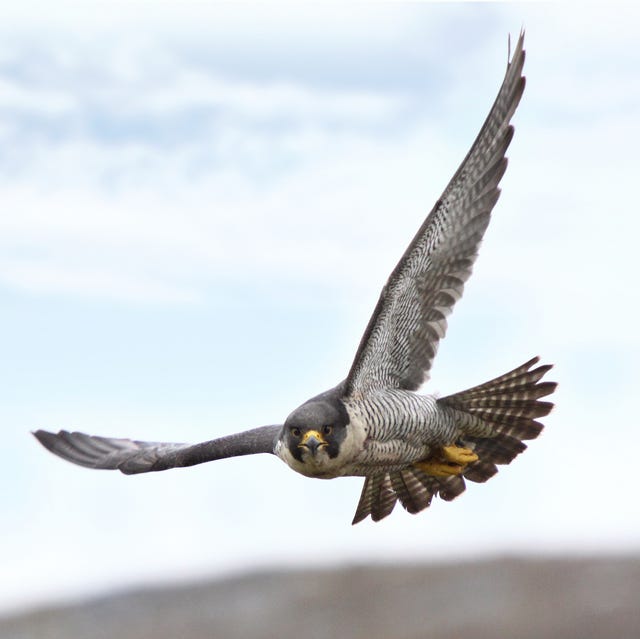
→ Birds rely on their airfoil-shaped wings to generate enough lift force to equal and surpass their weight. But different types of birds rely on different modes of flight to generate lift force. (Hummingbirds hover thanks to a vortex that forms above their flapping wings.) Birds generate thrust by flapping their wings in a figure-eight motion. On the downstroke, air hits the bottom of the wing and is deflected past the bird, propelling it forward. Increasing the depth of each wingstroke increases airspeed and lifts the bird.
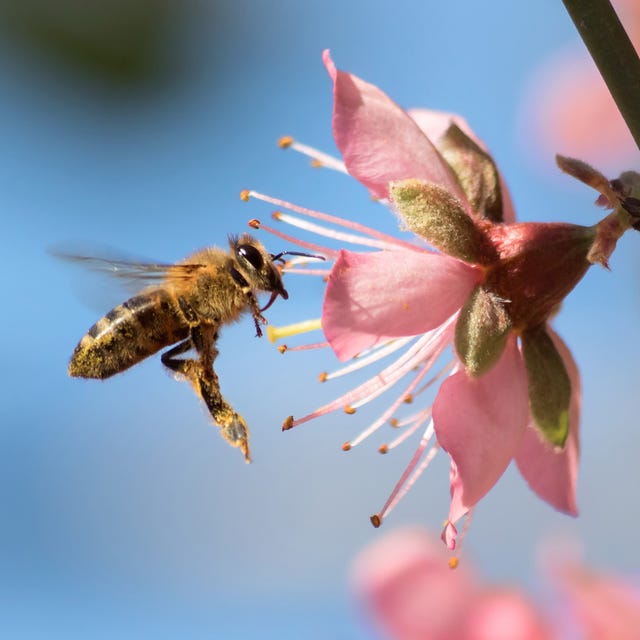
→ Bees have two sets of wings that they use to generate lift. As a bee rotates its wings back and forth, a small vortex forms above the wings’ leading edge, creating the lift force needed to keep the bee aloft. These soft and malleable wings move incredibly quickly, too, up to 230 beats per second. Compared to other insects of their size, this wingbeat is unusually fast. A fruit fly, for instance, is one eightieth the size of a honeybee and flaps its wings only 200 beats per second.

Sarah is a science and technology journalist based in Boston interested in how innovation and research intersect with our daily lives. She has written for a number of national publications and covers innovation news at Inverse .
Jennifer Leman is a science journalist and senior features editor at Popular Mechanics, Runner's World, and Bicycling. A graduate of the Science Communication Program at UC Santa Cruz, her work has appeared in The Atlantic, Scientific American, Science News and Nature. Her favorite stories illuminate Earth's many wonders and hazards.
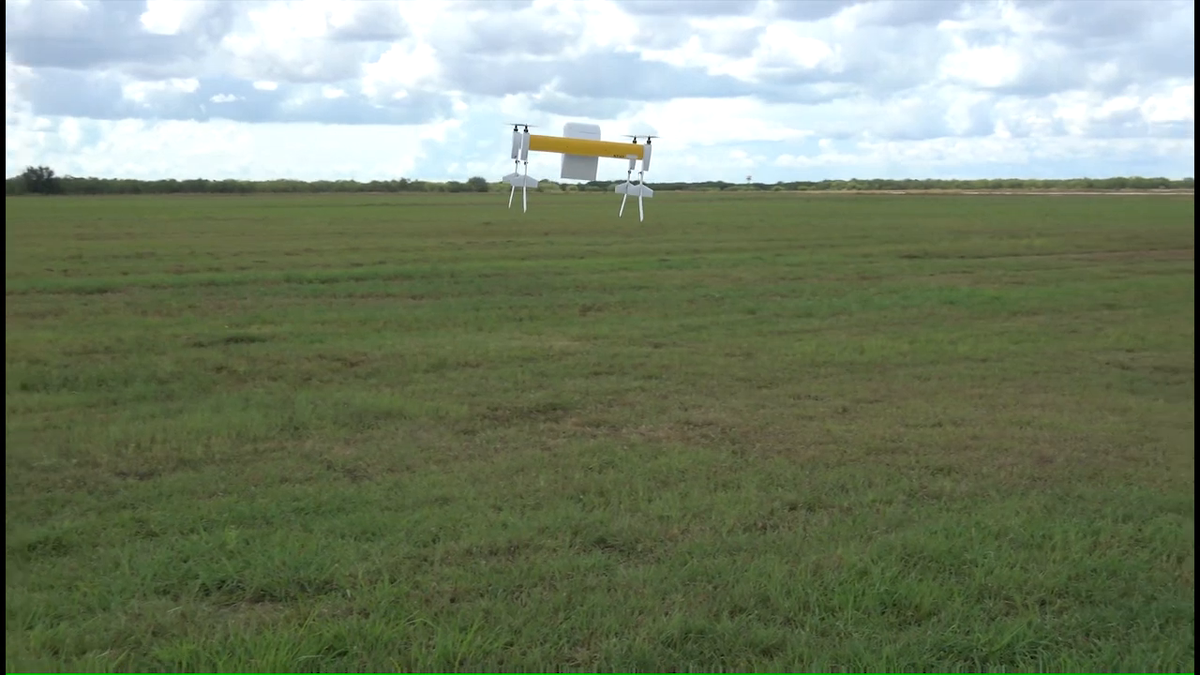
.css-cuqpxl:before{padding-right:0.3125rem;content:'//';display:inline;} Drones .css-xtujxj:before{padding-left:0.3125rem;content:'//';display:inline;}
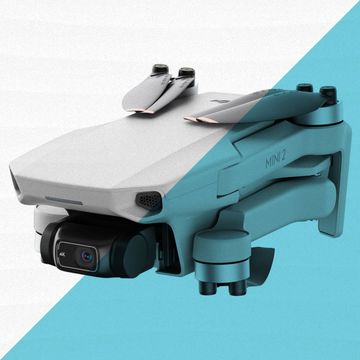
Fold Our Magazine Cover Into a Paper Airplane

How the CIA's Secretive Dragonfly Spy Works
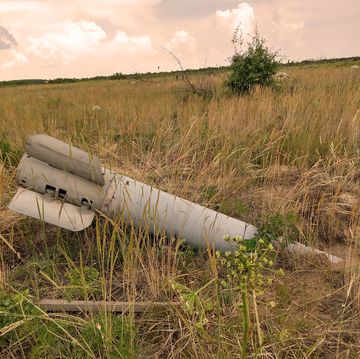
The Drones That Track Down Buried Warheads

This AI Software Helps Drones Save Lives
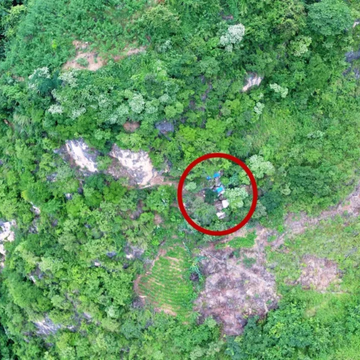
Police Drone Finds Fugitive Living in a Cave
What Happens When a Drone Crashes Into Your Face?
Japan Tests New Flying Car Prototype
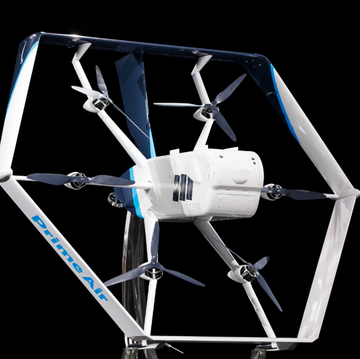
This Is Amazon's New Hexagonal Drone
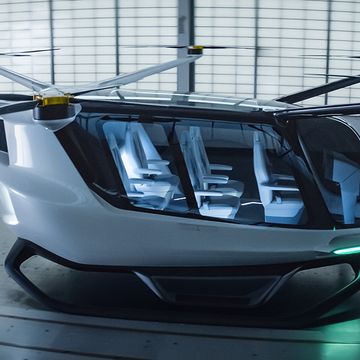
This Drone Transport Is Powered By Hydrogen Fuel
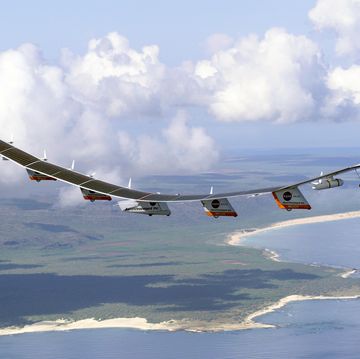
The Best Solar Drones That Are Filling the Skies

New Lithium Metal Battery Powers Drones for Longer
- Skip to primary navigation
- Skip to main content

General Aviation News
Because flying is cool
For latest research on aerodynamics, scientists turn to paper airplanes
By General Aviation News Staff · October 3, 2022 ·

A series of experiments using paper airplanes reveals new aerodynamic effects, according to researchers at New York University.
They say their findings “enhance our understanding of flight stability” and could inspire new types of flying vehicles.
“The study started with simple curiosity about what makes a good paper airplane and specifically what is needed for smooth gliding,” explains Leif Ristroph, an associate professor at New York University’s Courant Institute of Mathematical Sciences and an author of the study, which appears in the Journal of Fluid Mechanics.
“Answering such basic questions ended up being far from child’s play. We discovered that the aerodynamics of how paper airplanes keep level flight is really very different from the stability of conventional airplanes.”
“Birds glide and soar in an effortless way, and paper airplanes, when tuned properly, can also glide for long distances,” adds author Jane Wang, a professor of engineering and physics at Cornell University. “Surprisingly, there has been no good mathematical model for predicting this seemingly simple but subtle gliding flight.”
Since we can make complicated modern airplanes fly, the researchers say, one might think we know all there is to know about the simplest flying machines.
“But paper airplanes, while simple to make, involve surprisingly complex aerodynamics,” notes Ristroph.
The researchers began their study by considering what is needed for a plane to glide smoothly. Since paper airplanes have no engine and rely on gravity and proper design for their movement, they are good candidates for exploring factors behind flight stability, they said.
To investigate this phenomenon, the researchers conducted lab experiments by launching paper airplanes with differing centers of mass through the air. The results, along with those from studying plates falling in a water tank, allowed the team to devise a new aerodynamic model and also a “flight simulator” capable of predicting the motions.
To find the best design, the researchers placed different amounts of thin copper tape on the front part of the paper planes, giving them varied center of mass locations. Lead weights added to the plates in water served the same purpose.
“The key criterion of a successful glider is that the center of mass must be in the ‘just right’ place,” Ristroph says. “Good paper airplanes achieve this with the front edge folded over several times or by an added paper clip, which requires a little trial and error.”
The researchers discovered that flight motions depended on finding that “just right” place.
For example, if the weight was at the center of the wing or only displaced somewhat from the middle, it underwent wild motions, such as fluttering or tumbling. If the weight was displaced too far toward one edge, then the flier quickly dove downwards and crashed. In between, however, there was a “sweet spot” for the center of mass that gave stable gliding.
The researchers coupled the experimental work with a mathematical model that served as the basis of a “flight simulator,” a computer program that successfully reproduced the different flight motions. It also helped explain why a paper airplane is stable in its glide. When the center of mass is in the “sweet spot,” the aerodynamic force on the plane’s wing pushes the wing back down if the plane moves upward and back up if it moves downward, the researchers explain.
“The location of the aerodynamic force or center of pressure varies with the angle of flight in such a way to ensure stability,” Ristroph says.

He notes that this dynamic does not occur with conventional aircraft wings, which are airfoils, structures whose shapes work to generate lift.
“The effect we found in paper airplanes does not happen for the traditional airfoils used as aircraft wings, whose center of pressure stays fixed in place across the angles that occur in flight,” Ristroph says. “The shifting of the center of pressure seems to be a unique property of thin, flat wings, and this ends up being the secret to the stable flight of paper airplanes.”
“This is why airplanes need a separate tail wing as a stabilizer while a paper plane can get away with just a main wing that gives both lift and stability,” he concludes. “We hope that our findings will be useful in small-scale flight applications, where you may want a minimal design that does not require a lot of extra flight surfaces, sensors, and controllers.”
Reader Interactions
Share this story.
- Share on Twitter Share on Twitter
- Share on Facebook Share on Facebook
- Share on LinkedIn Share on LinkedIn
- Share on Reddit Share on Reddit
- Share via Email Share via Email
Join 110,000 readers each month and get the latest news and entertainment from the world of general aviation direct to your inbox, daily. Sign up here .
Curious to know what fellow pilots think on random stories on the General Aviation News website? Click on our Recent Comments page to find out. Read our Comment Policy here .
October 4, 2022 at 7:50 am
Interesting subject. When I was young, and could not afford any kind of flying machine, I found relief from my flying passion by building paper models. Some of them were actually aerodynamically impressive, with very shallow glides and very stable. Since I lived in a mountainous area I could let them go and at times get lucky were some would catch some lift and fly for a while. During those moments I would dream of one day flying a real aircraft. Eventually that lead to flying RC models, getting my private license and eventually a fun life engaged in different forms of aviation activities.
Thanks for reminding me of this fun aspect of my aviation career.
Paper Airplanes Plans
A glider is a special kind of aircraft that has no engine. In flight, a glider has three forces acting on it as compared to the four forces that act on a powered aircraft. Both types of aircraft are subjected to the forces of lift, drag, and weight. The powered aircraft has an engine that generates thrust, while the glider has no thrust.
Types of Glider Aircraft
There are many different types of glider aircraft. Paper airplanes are the simplest aircraft to build and fly, and students can learn the basics of aircraft motion by flying paper airplanes. Building and flying balsa wood or Styrofoam gliders is an inexpensive way for students to have fun while learning the basics of aerodynamics. Hang-gliders are piloted aircraft that are launched by leaping off the side of a hill or by being towed aloft. Piloted gliders are launched by ground based catapults, or are towed aloft by a powered aircraft then cut free to glide for hours over many miles. The Wright Brothers perfected the design of the first airplane and gained piloting experience through a series of glider flights from 1900 to 1903. The Space Shuttle flies as a glider during reentry and landing; the rocket engines are used only during liftoff.
On the graphic at the top of this page, there are two paper airplane designs shown: Paper Airplane #1 (PA-1), in blue at the lower right, and Paper Airplane #2 (PA-2), in red at the upper left. Both of these aircraft are constructed by folding an 8 1/2 by 11 sheet of paper. The plans for these aircraft are provided below.
To obtain your own copy of PA-1 click here and save the Power Point file. Open Power Point and follow the directions written on the aircraft to obtain a two-sided copy of the plans from your printer. The plans will look like this:
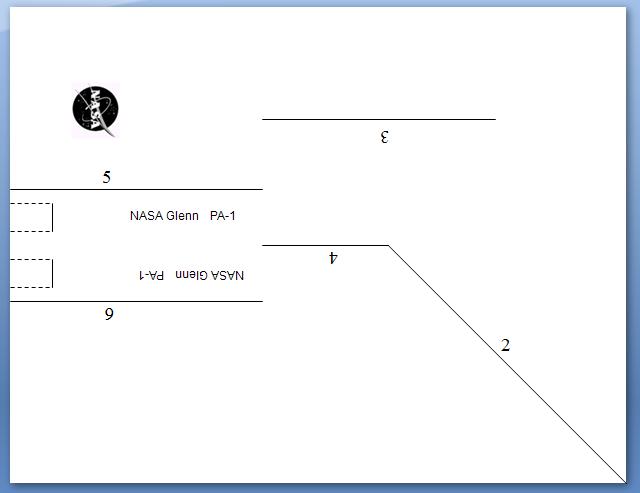
Constructing an Aircraft
To construct the aircraft, fold on the solid lines in the prescribed numerical order (1,2,3..) always folding to the inside. Cover the number with the fold. The dashed lines on the plans indicate places to cut with a scissors. The PA-1 is designed to be highly maneuverable and employs both ailerons and a rudder. If both ailerons are turned upward, the aircraft will loop. If one is turned up and the other down, and the rudder is fixed straight, the aircraft will roll. If the rudder is turned, the aircraft will perform a banked turn.
To obtain your own copy of PA-2 click here and save the Power Point file. Open Power Point and follow the directions written on the aircraft to obtain a two-sided copy of the plans from your printer. The plans will look like this:
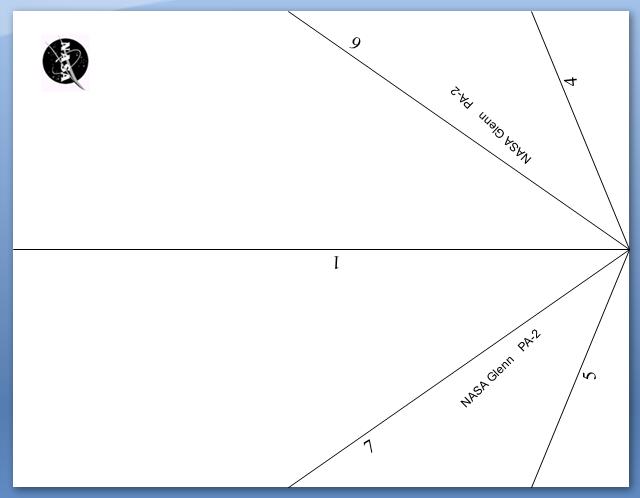
To construct the aircraft, fold on the solid lines in the prescribed numerical order (1,2,3..) always folding to the inside. Cover the number with the fold. The PA-2 is designed to fly fast and far.
Students should build and fly both aircraft to learn how differences in design affect the flight performance of an aircraft. After experimenting with paper airplanes, the student is ready to move up to more challenging aircraft such as wooden or Styrofoam gliders.
Thanks for contacting us! We will get in touch with you shortly.
February 28, 2013
Soaring Science: Test Paper Planes with Different Drag
An aerodynamic activity from Science Buddies
By Science Buddies
Key concepts Aerodynamics Planes Forces Drag Physics
Introduction Have you ever wondered what makes a paper plane fly? Some paper planes clearly fly better than others. But why is this? One factor is the kind of design used to build the plane. In this activity you'll get to build a paper plane and change its basic design to see how this affects its flight. There's a lot of cool science in this activity, such as how forces act on a plane so it can fly. So get ready to start folding!
Background The forces that allow a paper plane to fly are the same ones that apply to real airplanes. A force is something that pushes or pulls on something else. When you throw a paper plane in the air, you are giving the plane a push to move forward. That push is a type of force called thrust. While the plane is flying forward, air moving over and under the wings is providing an upward lift force on the plane. At the same time, air pushing back against the plane is slowing it down, creating a drag force. The weight of the paper plane also affects its flight, as gravity pulls it down toward Earth. All of these forces (thrust, lift, drag and gravity) affect how well a given paper plane's voyage goes. In this activity you will increase how much drag a paper plane experiences and see if this changes how far the plane flies.
On supporting science journalism
If you're enjoying this article, consider supporting our award-winning journalism by subscribing . By purchasing a subscription you are helping to ensure the future of impactful stories about the discoveries and ideas shaping our world today.
Materials • Sheet of paper • Ruler • Scissors • Large open area in which to fly a paper plane, such as a long hallway, school gym or basketball court. If you're flying your paper plane outside, such as in a field, try to do it when there isn't any wind. • Something to make at least a one-foot-long line, such as a long string, another ruler, masking tape, rocks or sticks. • Paper clips (optional)
Preparation • Make a standard, "dart" design paper airplane (for instructions, go to the Amazing Paper Airplanes Web page ). • Fold your paper into the basic dart paper plane. Fold carefully and make your folds as sharp as possible, such as by running a thumbnail or a ruler along each fold to crease it. Do not bend up the tailing edge of the wings (step 6 of the online folding instructions). • Go to a large open area and, using string, a ruler, masking tape, rocks or sticks, make a line in front of you that's at least one foot long, going from left to right. This will be the starting line from which you'll fly the paper plane.
Procedure • Place your toe on the line you prepared and throw the paper plane. Did it fly very far? • Throw the plane at least four more times. Each time before you throw the plane, make sure it is still in good condition (that the folds and points are still sharp). When you toss it, place your toe on the line and try to launch the plane with a similar amount of force, including gripping it at the same spot. Did it go about the same distance each time? • Once you have a good idea of about how far your plane typically flies, change the plane’s shape to increase how much drag it experiences. To do this, cut slits that are about one inch long right where either wing meets the middle ridge. Fold up the cut section on both wings so that each now has a one-inch-wide section at the end of the wing that is folded up, at about a 90-degree angle from the rest of the wing. • Throw your modified paper plane at least five more times, just as you did before. How far does the paper plane fly now compared with before? Why do you think this is, and what does it have to do with drag? • Extra: Make paper planes that are different sizes and compare how well they fly. Do bigger planes fly farther? • Extra: Try making paper planes out of different types of paper, such as printer paper, construction paper and newspaper. Use the same design for each. Does one type of paper seem to work best for making paper planes? Does one type work the worst? • Extra: Some people like to add paper clips to their paper planes to make them fly better. Try adding a paper clip (or multiple paper clips) to different parts of your paper plane (such as the front, back, middle or wings) and then flying it. How does this affect the plane's flight? Does adding paper clips somewhere make its flight better or much worse? Observations and results Did the original plane fly the farthest? Did the plane with increased drag fly a much shorter distance?
As a paper plane moves through the air, the air pushes against the plane, slowing it down. This force is called drag. To think about drag, imagine you are in a moving car and you put your hand out the window. The force of the air pushing your hand back as you move forward is drag, also sometimes referred to as air resistance. In this activity you increased how much drag acted on the paper plane by making a one-inch-high vertical strip on both wings. For example, this is what happens when you're in a moving car with your hand out the window and you change its position from horizontal to vertical. When your hand is held out vertically, it catches a greater amount of air and experiences a greater drag than when it is horizontal. You could probably feel this, as your hand would be more forcefully pushed back as the car moves forward. This is what happened to the modified plane—it experienced a greater amount of drag, which pushed it back more than the original plane. This experiment has clearly demonstrated that altering how just one force acts on a paper plane can dramatically change how well it flies.
Cleanup Recycle the paper plane when you are done with it.
More to explore Dynamics of Flight: Forces of Flight , from NASA What Makes Paper Airplanes Fly? , from Scholastic Forces of Flight—Drag , from The Franklin Institute How Far Will It Fly? Build and Test Various Paper Planes , from Science Buddies
This activity brought to you in partnership with Science Buddies
an analogy for every complexity
The science behind paper airplanes.
- Explanations
15 Comments
Have you ever thrown a paper airplane? How did it fly? Paper airplanes vary widely in design, and those differences lead to meaningful differences in the way that they fly. Some airplanes fly quickly through the air, while others glide slowly. Sometimes, a paper airplane will tip its nose upward, leading to a stall. Why do these things happen?
The mechanics of paper airplanes are interesting because they are similar to those of most things that move quickly through the air. They have four basic forces acting on them:
via auntannie.com
The thrust comes from you when you throw the plane. Thus, the plane has no thrust in flight. The reason it doesn’t continue to slow down during flight is because it is also falling, “converting” its potential energy into thrust as it falls.
The lift comes from the difference in air pressure above and below the wing. This is caused by the shape of the wing, known as an airfoil. Lift is proportional to the size of the wing and the square of the speed of the plane.
So how do these forces affect how a plane flies? Take for example the standard paper “dart” plane:
via Wikigami
If you have flown this plane before, you know that it flies quickly, but drops to the ground relatively quickly. This can be explained as the plane having little drag, but little lift as well. More specifically, the lift and gravity forces are not perfectly aligned like they are in the first image. Rather, the center of gravity is slightly ahead of the center of lift in this plane, causing it to tip downwards and fly towards the ground.
Another popular plane is this “glider”:

via Instructables
This plane has a slow and steady flight if thrown gently or even dropped from a high place. Even without thrust from the person who throws it, it is able to maintain steady flight, if at the cost of a slight drop at the beginning. This indicates that its gravity and lift forces are aligned correctly. While it does not fly as fast, it has a larger wing surface area, which allows it to get enough lift at lower speeds.
With these ideas in mind, it’s easy to pick the correct airplane for any task. (That’s a common issue people have… right?) I once participated in a paper airplane competition based on longest total flight time. Knowing this, I instantly started folding large-winged gliders. When my plane nosedived too often, I folded it to place less paper in the front half, which moved the center of mass further back to compensate for the nosediving, which led to a steady-flying glider.
I went on to win $20 in that small competition. While, in real life, paper airplanes competitions are few and far between, this knowledge is not useful exclusively in these rare situations. Just to understand the basic mechanics at work in the planes, drones, and squirrel suits of the world is enlightening.
I have made lots of paper airplanes and lots of them failed this is a very detailed way to look at something so simple.
I agre I lyke paper airplanes because they are cool and soemtime I get them to fly. My bike is red and has stuff on the grip bars. What is yoru bike like.
are you in special ed classes?
Why was the necessary? If it was because of a few spelling errors by the previous poster than you don’t have much to talk about as your post had no capital letter at the beginning of your sentence.
Meow fuck out the way.
Come on people show some respect
Thank you for this post Gemlik Zeytin Fidanı
say my name
Heisenberg!
Am using this as research for my Engineering project. Very helpful, thanks!
allauh akbar 💥💥💥
Where’s my cupcake?
there are kids
Leave a Reply Cancel reply
Your email address will not be published. Required fields are marked *
Save my name, email, and website in this browser for the next time I comment.

IMAGES
VIDEO
COMMENTS
Based on performance, the Wide Stunt paper plane has produced better and maximum aerodynamic efficiency () magnitudes compared to the other design. Wide Stunt paper plane induced at least 6.4% ...
A series of experiments using paper airplanes reveals new aerodynamic effects, a team of scientists has discovered. Its findings enhance our understanding of flight stability and could inspire new types of flying robots and small drones. "The study started with simple curiosity about what makes a good paper airplane and specifically what is ...
Nobody knows who invented the first paper airplane, but China began making paper on a large scale around 500 BCE, with the emergence of origami and paper-folding as a popular art form between 460 ...
Paper plane has a high potential to be upgraded as a Micro Air Vehicle (MAV). Due to its simplicity, paper plane offers easier design option compared to the biological inspired designs as shown in recent MAV development. However, researchers have underestimate and overlook the basic aerodynamic performance induced by these paper planes.
There are three different paper plane design have been selected for current works. The selection is made based on its popular usage as paper plane toys and recommendation to be used with PowerUp 3.0 device. PowerUp 3.0 [11] is a device that can remotely control a paper airplane through a Bluetooth® connected smartphone.
The research could influence the development of airborne vehicles like drones. The team's research was published in the Journal of Fluid Mechanics. "The study started with simple curiosity about what makes a good paper airplane and specifically what is needed for smooth gliding," said Leif Ristroph, an author of the study.
A series of experiments using paper airplanes has revealed new aerodynamic effects, researchers report. The findings enhance our understanding of flight stability and could inspire new types of ...
This paper is based on work done when both authors were at the Indian Institute of Technology Gandhinagar, Palaj, Gujarat, India, between 2014 and 2016; the first author was a graduate student supported by a Govt. of India MHRD Scholarship for his MTech degree studies in Mechanical Engineering while the second author was a Professor of Mechanical Engineering.
The design of Micro Air Vehicles (MAV) is challenging since the aerodynamic efficiency of airfoils and wings decreases at low Reynolds-numbers. While many MAV approaches investigate biological designs, we present an investigation on the aerodynamics of paper airplanes, which fly in the same Reynolds-number range as MAV, but have the advantage of simplicity. We present flow visualizations and ...
Paper airplanes give aerodynamic insights. Research unveils mechanisms that explain flight stability, inspiration for drones. Trajectories of plates falling through water, where the different colors represent different degrees of front weighting. Only the right weight distribution leads to the smooth gliding shown in blue.
Film Synopsis. After he wins his school's paper plane making contest, 11-year-old Dylan and his grief-stricken father reconnect as Dylan prepares for the World Paper Plane Championships in Tokyo. Paper Planes tells the story of a young Australian boy's passion for flight and his journey to compete in the world paper plane championships in Japan.
Identify a safe place where students can test their paper airplane designs. Premark the testing area at 100-cm increments; a measured range from 1,000 cm (10 m) to 2,500 cm (25 m) is recommended. • Have students research paper airplanes online to become familiar with different styles, different classifications, and what to expect
Shinji Suzuki met Takuo Toda in 1999, atop Mt. Yonami in the southern city of Jinseki-Kogen, Japan. Toda, the chairman of the Japan Origami Airplane Association, was there to launch a large paper ...
A series of experiments using paper airplanes reveals new aerodynamic effects, a team of scientists has discovered. Its findings enhance our understanding of flight stability and could inspire new types of flying robots and small drones. "The study started with simple curiosity about what makes a good paper airplane and specifically what is ...
For latest research on aerodynamics, scientists turn to paper airplanes. A series of experiments using paper airplanes reveals new aerodynamic effects, according to researchers at New York University. They say their findings "enhance our understanding of flight stability" and could inspire new types of flying vehicles.
Paper Airplanes Plans Paper Airplane #2 (PA-2) & Paper Airplane #1 (PA-1) Glider. A glider is a special kind of aircraft that has no engine. In flight, a glider has three forces acting on it as compared to the four forces that act on a powered aircraft. ... Glenn Research Center. 21000 Brookpark Road Cleveland, OH 44135 (216) 433-4000. nasa.gov ...
The weight of the paper plane also affects its flight, as gravity pulls it down toward Earth. All of these forces (thrust, lift, drag and gravity) affect how well a given paper plane's voyage goes ...
The mechanics of paper airplanes are interesting because they are similar to those of most things that move quickly through the air. They have four basic forces acting on them: via auntannie.com. The thrust comes from you when you throw the plane. Thus, the plane has no thrust in flight.
As a paper plane moves through the air, the air pushes against the plane, slowing it down. This force is called drag. To think about drag, imagine you are in a moving car and you put your hand out the window. The force of the air pushing your hand back as you move forward is drag, also sometimes called air resistance.
Follow the paper airplane template for the "intermediate" design instructions to build a paper airplane. Build two more so that you have a total of three paper planes. They should all look identical. Make a data table in your lab notebook, like Table 1 below, where you can record the data you get from your experiment.